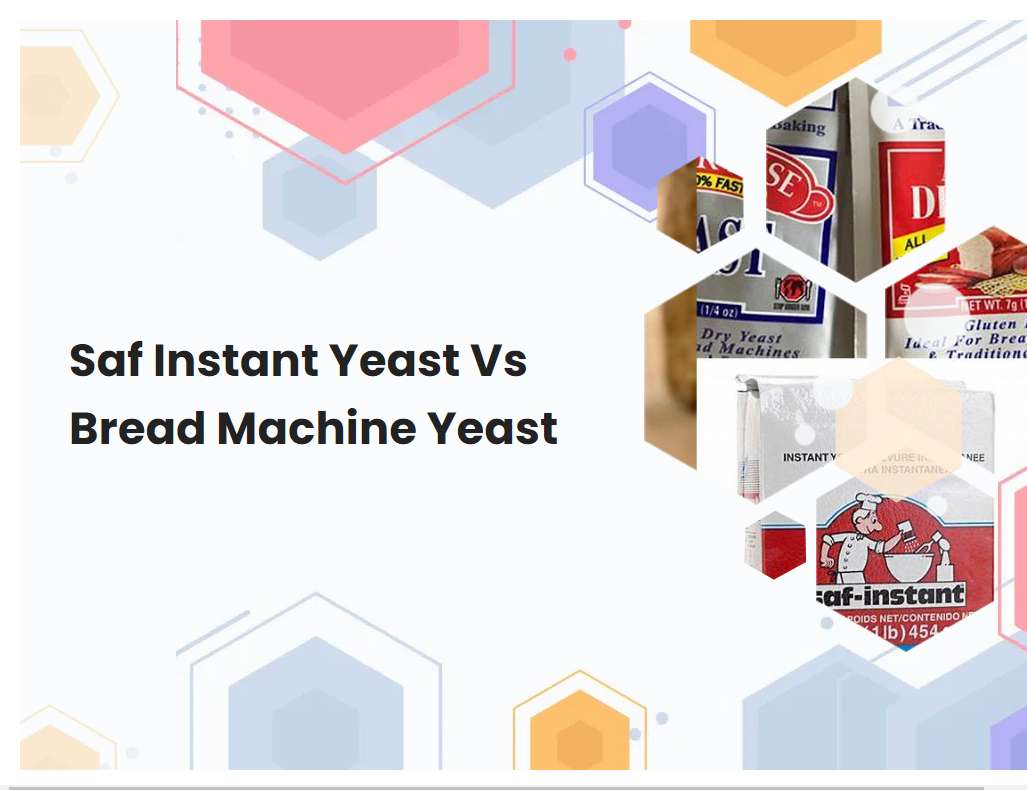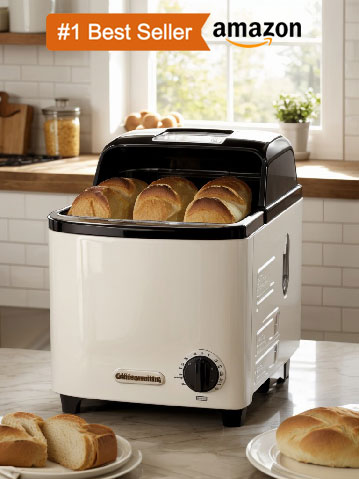Saf Instant Yeast Vs Bread Machine Yeast
Yeast is a type of fungus that is essential for the production of bread. There are two main types of yeast used for making bread: active dry yeast and instant yeast. Active dry yeast and bread machine yeast are both forms of active dry yeast, while instant yeast is a different form of yeast altogether. Each type of yeast is suitable for different types of baking, and it is important to understand the differences between them in order to achieve the best results.

Instant yeast (also known as rapid rise, quick rise, or bread machine yeast) is a type of dry yeast that does not require proofing and can be added directly to a recipe.
Instant yeast is a type of dry yeast that many bakers prefer for its convenience and time-saving properties. Unlike active dry yeast, it does not need to be proofed (hydrated) before being added to a recipe. This makes it especially helpful when making breads, rolls, and pizza dough as it can be added directly to the dry ingredients.
It also tends to work faster than active dry yeast, cutting down on rising time. This type of yeast is also known as rapid rise, quick rise, or bread machine yeast and is available in both conventional and organic varieties. It is important to store instant yeast properly in a cool, dry place and to use it before its expiration date for best results. With its ease of use and fast-acting nature, instant yeast is a popular choice for many bakers.
Instant yeast is slightly more potent than traditional active dry yeast, so you will need to use less of it in a recipe.
Instant yeast is a type of yeast that is milled into a finer texture and ultimately has a higher concentration of active cells than regular active dry yeast. This higher concentration makes it more potent, meaning you can use a smaller amount in your recipe. Generally, you only need to use about two-thirds of the amount of instant yeast that you would use for active dry yeast.
Instant yeast also does not need to be dissolved in water before use, which makes it a great time-saver. It is important to note, however, that instant yeast should not be exposed to temperatures above 130°F or it will lose its potency. Therefore, when using it in a recipe, it is best to add it after the liquid ingredients have been combined and cooled slightly. Instant yeast is an ideal choice for bread makers and bakers who are looking for a reliable and consistent rise in their baked goods.
See also: Bread Machine With Yeast Dispenser Hand Mix
Instant yeast is granulated like sugar, so it dissolves more quickly in liquids.
Instant yeast, also known as rapid-rise, fast-acting, or bread machine yeast, is a type of yeast that is specifically designed to dissolve quickly in liquids. Unlike active dry yeast, which needs to be completely dissolved and activated in water before use, instant yeast can be added directly to a recipe's ingredients without rehydrating in water. Instant yeast is made from the same strain of yeast as active dry yeast, but it is milled into finer granules, allowing it to dissolve more quickly and easily.
This makes it ideal for recipes that require speed and convenience, such as quick breads and pizza doughs. Furthermore, instant yeast only requires one rise time, whereas active dry yeast requires two rise times. This makes instant yeast the preferred choice for many bakers who need to have their dough ready quickly.
See also: What Is The Rapid Setting On Bread Machine
Bread machine yeast is a specialized type of instant yeast that is designed for use in bread machines and is formulated for optimal performance in those machines.
Bread machine yeast is a type of instant yeast that has been specifically designed for use in bread machines. It is formulated to provide optimal performance in bread machines, resulting in perfectly risen dough with a light, fluffy texture. The yeast comes in a granular form and is activated quickly, allowing the dough to rise quickly and evenly.
Bread machine yeast is an excellent choice for home bakers who want to save time and effort when creating homemade breads. It's also great for those who may be new to bread making, as bread machine yeast helps ensure uniform results and eliminates any guesswork. Bread machine yeast does not need to be proofed or activated like other types of yeast, making it easy to use and ready to go as soon as it's added to the dough.
See also: Sweet Butter Rolls Bread Machine Bake In Oven
Bread machine yeast is faster-acting than other types of yeast, so you don't need to wait for the dough to rise before baking.
Bread machine yeast is a type of yeast that is specifically designed for use in bread machines. It is typically sold in small packets and has a finer granular texture than active dry yeast. It is a fast-acting yeast, meaning that it can start the dough rising much quicker than active dry yeast.
This is great for bread machine users who don't have time to wait for dough to rise before baking. Bread machine yeast requires less kneading time because of its fast-acting properties. As a result, breads made with bread machine yeast are usually light, airy, and soft. Additionally, bread machine yeast produces a higher rise in the dough than active dry yeast, resulting in a fluffier loaf of bread. Overall, bread machine yeast is an ideal choice for anyone who wants to make fresh bread in a hurry.
See also: Black And Decker Bread Machine Not Working
Bread machine yeast may produce a slightly different flavor or texture than other types of yeast.
Bread machine yeast is a type of yeast specifically designed to work best in bread machines. It is composed of a combination of active dry yeast and dough conditioners that help to provide a consistent rise and texture. This type of yeast will give bread doughs a slightly different flavor and texture than other types of yeast, such as instant or rapid rise yeast.
The dough conditioners in bread machine yeast help to improve the texture of the finished product, resulting in a softer, fluffier crumb. Bread machine yeast is well-suited for use in bread machines, as it can be added directly to the dry ingredients for a quick and easy dough. It is also effective for making doughs that require long, slow rises, such as sourdough. When used in traditional bread recipes, bread machine yeast may result in a slightly different flavor and texture than other types of yeast, but the difference will be subtle and is unlikely to affect the overall taste of the finished product.
See also: Bread Machine All Opions Are My Own
Bread machine yeast should always be stored in a cool, dry place.
Bread machine yeast is an essential ingredient for baking bread in a bread machine. It is important to store it correctly to ensure it stays fresh and active. Bread machine yeast should always be stored in a cool, dry place.
This means avoiding heat and direct sunlight, and avoiding any areas where there is moisture or humidity. An ideal place to store it would be in the pantry, in an airtight container or bag. If the yeast is stored in an area that is too warm, it can become inactive and will not work properly when used in baking. Additionally, be sure to use the yeast before its expiration date. Storing it in the correct way will ensure that the yeast is always fresh and active when used.
Instant yeast is not suitable for recipes that require long, slow rises.
Active dry yeast is the most commonly used yeast for home baking, but instant yeast is a great alternative. Instant yeast is a type of active dry yeast with smaller granules, so it can be added directly to dry ingredients without needing to be rehydrated. This makes instant yeast more convenient and faster to use than active dry yeast.
However, because of its fine granules, instant yeast works best in recipes that require shorter rising times. Recipes that require long, slow rises, such as sourdough bread, are better suited to active dry yeast. Active dry yeast needs to be rehydrated in warm water before being added to the recipe, but its larger granules allow it to better absorb moisture and activate slowly over time. This slow activation works well for recipes that need a longer rise time, such as sourdough bread. Overall, instant yeast is great for convenience and speed, but active dry yeast is better for recipes requiring long, slow rises.
Instant yeast can be used as a substitute for active dry yeast in most recipes.
Using instant yeast as a substitute for active dry yeast can be a great way to simplify your baking process. Instant yeast, also known as quick-rise or rapid-rise yeast, has a finer texture than active dry yeast and does not need to be dissolved in water before use. It can usually be added directly to the dry ingredients in a recipe and will begin to work immediately.
Instant yeast also has a higher rise rate than active dry yeast and can cut down significantly on the rising time of a dough. However, if a recipe calls for active dry yeast, it is best to stick with that, as instant yeast may require a slight adjustment of the other ingredients or the rising time.
The shelf life of instant and bread machine yeast is generally longer than that of active dry yeast.
Instant yeast and bread machine yeast have a shelf life that is generally longer than active dry yeast. Instant yeast is a type of fast-acting yeast which does not need to be dissolved in water before using. This makes it much easier to use, and it can be added directly to the dry ingredients of a recipe.
It is also more tolerant of temperature and humidity fluctuations, so it can be stored without refrigeration. Bread machine yeast is specifically designed to be used in bread machines, and is also fast-acting and does not need to be dissolved in water. It is also more tolerant of temperature and humidity fluctuations and can be stored at room temperature. Both instant and bread machine yeasts have a shelf life of up to two years when stored properly in a cool, dry place. In comparison, active dry yeast has a shorter shelf life of around one year when stored in the same conditions.





